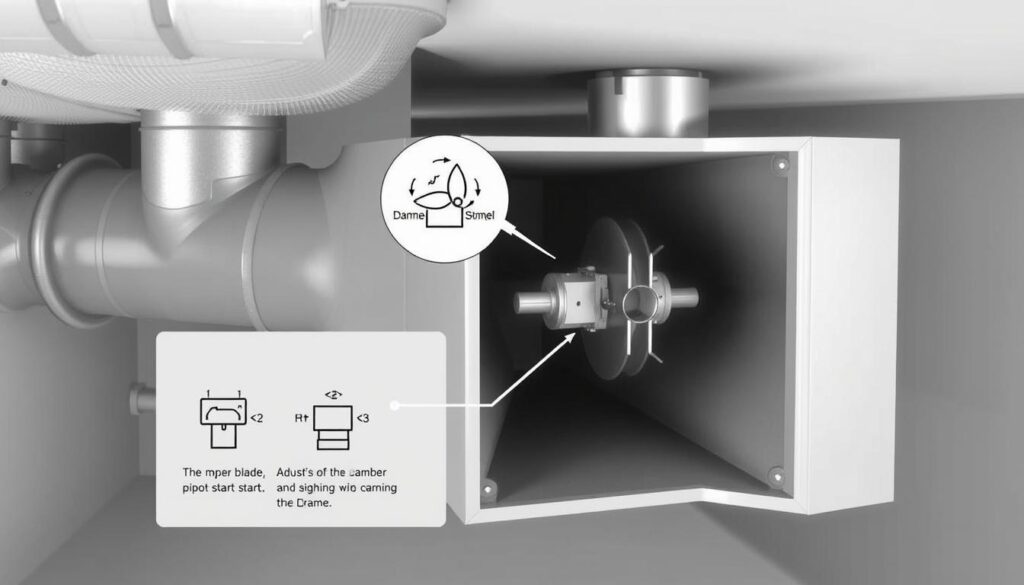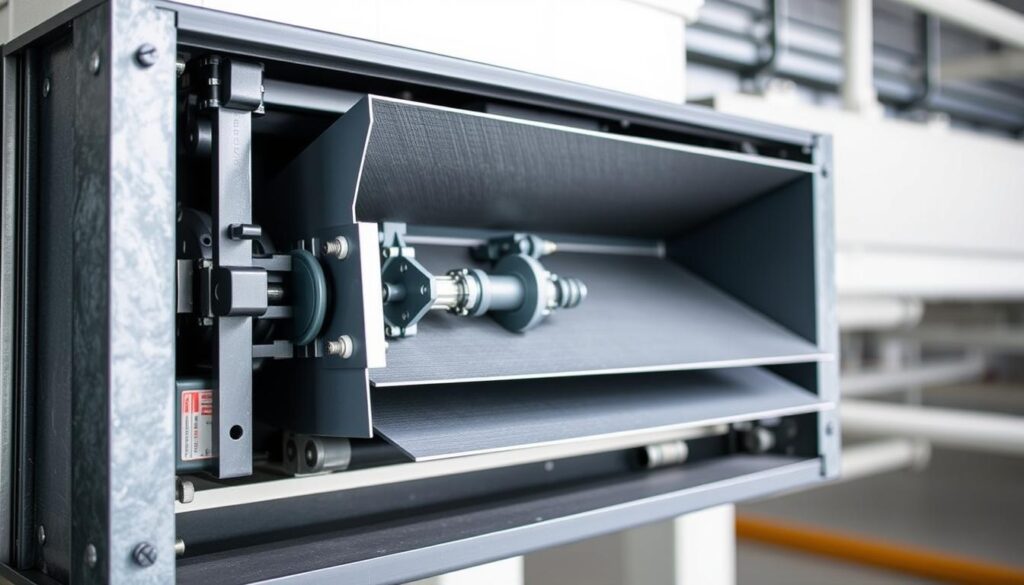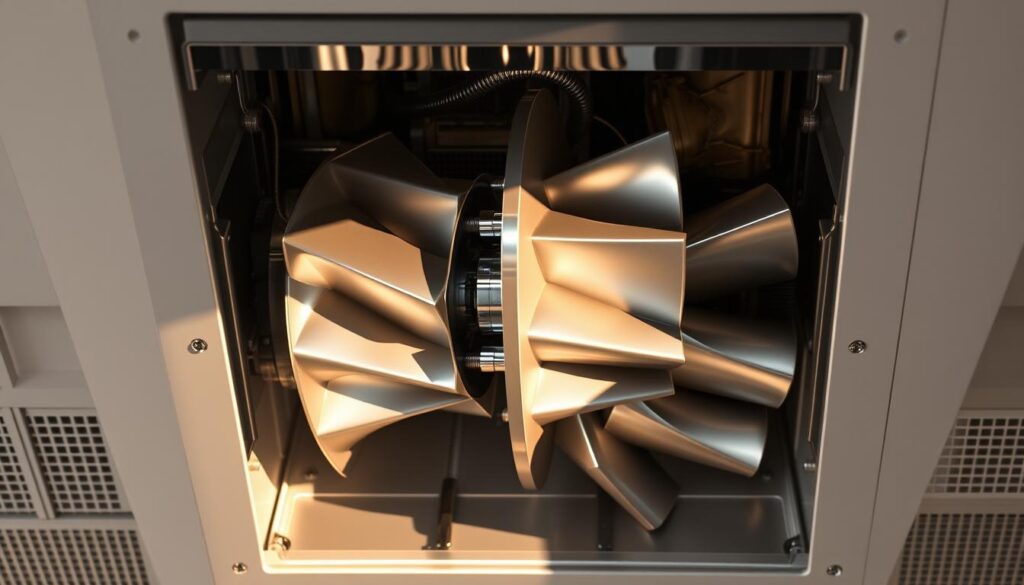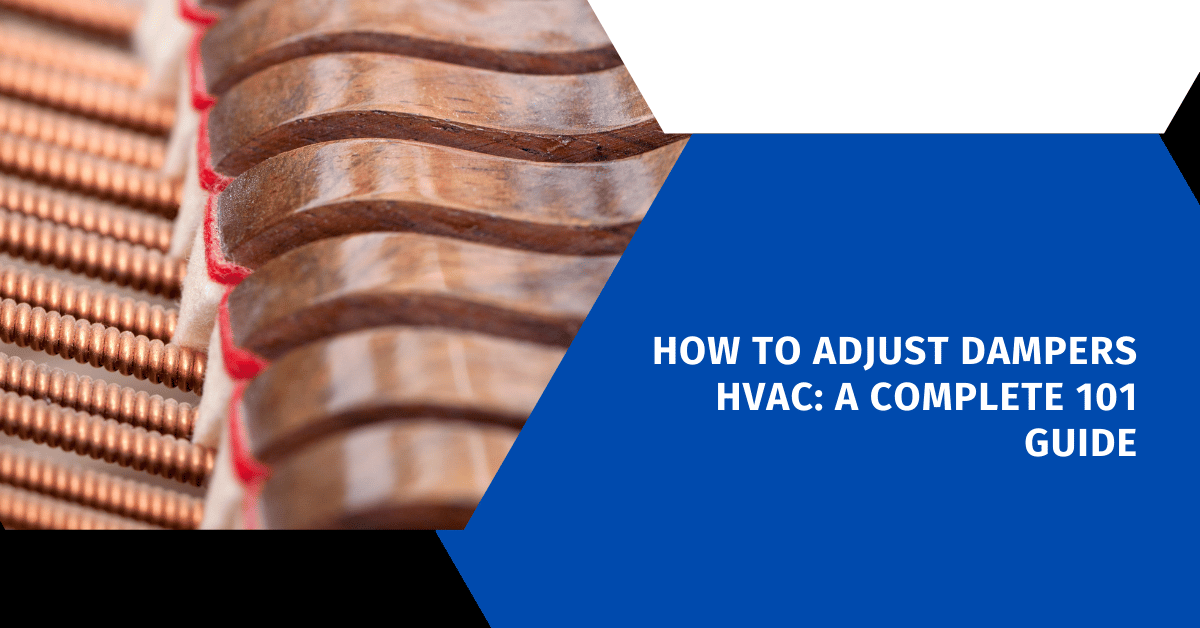Affiliate Disclosure
HVAC Guide Guys is a participant in the Amazon Services LLC Associates Program, an affiliate advertising program designed to provide a means for sites to earn advertising fees by advertising and linking to Amazon.
How to Adjust Dampers HVAC? HVAC dampers control airflow in your home. Learning to adjust them can make your home more comfortable and energy-efficient. These plates direct air to where you need it most.

Are you tired of uneven temperatures and high energy bills? The answer might be in your air ducts.
Knowing how to adjust HVAC dampers isn’t just for experts. Homeowners can save money and make their homes more comfortable with the right knowledge.
Key Takeaways
- HVAC dampers help balance temperature across different rooms
- Proper damper adjustment can significantly reduce energy costs
- DIY damper maintenance is possible with the right guidance
- Seasonal adjustments improve overall HVAC system performance
- Understanding damper function leads to better home comfort
Table of Contents
Understanding HVAC Dampers and Their Function
HVAC dampers are key parts of your home’s heating and cooling system. They help control airflow and temperature. These smart devices ensure your home stays comfortable and saves energy.
- Manual damper settings that need you to adjust them by hand
- Automatic dampers that use sensors and motors for control
Types of HVAC Dampers
Here are the common damper types:
- Volume dampers for adjusting air flow
- Backdraft dampers to stop air from coming back in
- Fire dampers to block air in emergencies
- Motorized zone dampers for exact temperature control
How Dampers Control Airflow
Dampers use metal plates in ductwork to control airflow. These plates can be turned to open or close, helping to balance temperatures in your home.
Components of Damper Systems
A damper system has several parts:
- Damper blade or plate
- Control mechanism (like a lever or motor)
- Linkage for moving the damper
- Sealing mechanism to keep air from leaking
Knowing about these parts helps you understand how to adjust dampers for better comfort at home.
Locating Your HVAC Dampers in Your Home
Finding your HVAC dampers is key for controlling airflow. They are hidden in your home’s ductwork, ready to be found and adjusted.
Homeowners can find dampers in these spots:
- Basement mechanical rooms
- Attic spaces
- Crawl spaces
- Near main trunk lines of ductwork
Look for small handles or levers on your ducts. Manual dampers have controls you can see. Automatic dampers might need a pro to find.
| Location Type | Typical Damper Visibility | Difficulty of Access |
|---|---|---|
| Basement | High | Easy |
| Attic | Medium | Moderate |
| Crawl Space | Low | Challenging |
Make a damper map for easier adjustments. Draw your ductwork layout and mark damper spots for quick access during maintenance.
Pro Tip: When in doubt, consult an HVAC professional who can help you identify and map your home’s damper system.
Explore Our HVAC Shop
Looking for top-rated HVAC tools, parts, and accessories? Visit our shop and find the perfect solution for your needs.
Visit the ShopBenefits of Proper Damper Adjustment
Your HVAC system is more than just a machine—it’s the comfort engine of your home. Learning how hvac zoning dampers work can change your living space and save money. Proper damper adjustment brings many benefits that go beyond just controlling temperature.
Adjusting your HVAC system with dampers brings many benefits that homeowners often miss. By managing airflow well, you can make your home more comfortable and efficient.
Energy Efficiency Improvements
Smart damper adjustments can cut your energy use a lot. Homeowners who use precise hvac zoning dampers see:
- 10-20% less in heating and cooling costs
- Less energy waste with precise airflow control
- Lower monthly utility bills
Enhanced Temperature Control
Proper damper management means no more uneven temperatures. Your home will stay comfortably warm or cool in every room, no more hot or cold spots.
Extended HVAC System Lifespan
By easing the load on your HVAC, balanced damper settings can make it last longer. Less stress means fewer repairs and a longer-lasting investment.
Intelligent damper adjustment is like giving your HVAC system a precision tune-up—every single day.
How to Adjust Dampers HVAC
Adjusting HVAC dampers can make your home more comfortable and save energy. To adjust dampers, you need to know the basics and safety steps.

Before you start adjusting furnace dampers, remember these important safety steps:
- Turn off your HVAC system completely
- Wear protective gloves and safety glasses
- Ensure proper ventilation in your work area
Adjusting manual dampers needs careful attention. Look for the damper handle on your ductwork. The handle’s position shows if the damper is open or closed:
- Parallel to the duct: Damper is fully open
- Perpendicular to the duct: Damper is fully closed
“Small, incremental changes are key to maintaining your HVAC system’s balance and efficiency.” – HVAC Professional
When adjusting, move the handle slowly and make small changes. Wait 24 hours after each adjustment to see how it affects your home’s temperature and airflow. This slow approach helps avoid overloading your HVAC system.
For homes with automatic dampers, use your thermostat or control panel for precise adjustments. Digital systems usually offer more detailed control than manual dampers.
Seasonal Damper Adjustment Guidelines
Learning to adjust heating damper controls all year can make your home more comfortable and save energy. Your HVAC damper settings should change with the seasons. This ensures the right airflow and temperature everywhere.
Knowing how to adjust your HVAC system’s dampers can change your home’s climate. Each season needs a different way to manage airflow for comfort.
Summer Settings for Optimal Cooling
In summer, your cooling plan needs smart damper settings:
- Open dampers to upper floors where heat builds up
- Partially close dampers to lower floors
- Send cool air mainly to warmer areas
Winter Settings for Even Heating
Winter calls for a different heating damper strategy:
- Open dampers to lower floors
- Partially close dampers to upper floors
- Use dampers to fight heat rise and keep warmth down
Transitional Season Adjustments
Spring and fall need careful hvac damper tweaks. These seasons have changing temperatures and different heating and cooling needs.
Slow, small damper changes help keep indoor temperatures just right. Watch how rooms feel and adjust dampers a little at a time for the best airflow.
Explore Our HVAC Shop
Looking for top-rated HVAC tools, parts, and accessories? Visit our shop and find the perfect solution for your needs.
Visit the ShopCommon Damper Problems and Solutions
HVAC airflow control can sometimes face challenges that affect your system’s performance. Knowing about common damper issues helps keep your home comfortable. It also helps avoid system breakdowns.
Stuck dampers are a common problem in HVAC systems. These parts can get stuck for many reasons:
- Dust and debris accumulation
- Lack of regular lubrication
- Mechanical wear and tear
- Corrosion from moisture exposure
When you try to adjust air flow dampers, you might run into some issues. Visual inspection is key to spotting mechanical problems. Look for signs like:
- Uneven airflow between rooms
- Unusual noises during system operation
- Inconsistent temperature distribution
- Visible rust or physical damage
Some problems can be fixed with simple maintenance. Try cleaning with compressed air, using special lubricants, and checking connections. But, if issues persist, you might need a pro.
Professional HVAC technicians suggest annual system checks to avoid big damper problems.
Signs that mean you need a pro right away include:
- Complete damper failure
- Malfunctions in electrical control systems
- Significant air leakage around damper edges
Maintaining Your HVAC Damper System
Keeping your HVAC damper system in good shape is key for comfort and saving energy. Regular maintenance helps your system work better. It also stops sudden breakdowns and makes your heating and cooling last longer.
Creating a Maintenance Routine
Having a regular maintenance plan is important. It keeps your HVAC dampers working well. Here are some steps to follow:
- Inspect dampers annually for signs of wear or damage
- Clean damper components to remove dust and debris
- Check for smooth opening and closing mechanisms
- Lubricate moving parts to prevent sticking
Cleaning and Care Guidelines
Cleaning your HVAC damper system right is key. Use soft brushes and mild cleaners to get rid of dust. Stay away from strong chemicals that could harm your dampers.
| Maintenance Task | Frequency | Key Actions |
|---|---|---|
| Visual Inspection | Every 6 months | Check for rust, damage, or misalignment |
| Deep Cleaning | Annually | Remove and clean damper blades carefully |
| Professional Checkup | Every 2-3 years | Comprehensive system evaluation |
Professional Maintenance Insights
Expert technicians say getting professional maintenance is a must for complex damper systems. While you can do some maintenance yourself, pros can spot problems you might miss.
Professional HVAC technicians can give detailed checks and make precise adjustments to keep your system running smoothly.
By sticking to these maintenance tips, you’ll get the most out of your HVAC damper system. You’ll save on energy costs and keep your home comfortable all the time.
Explore Our HVAC Shop
Looking for top-rated HVAC tools, parts, and accessories? Visit our shop and find the perfect solution for your needs.
Visit the ShopSmart HVAC Damper Technology

Modern home comfort is getting a boost from smart HVAC zoning dampers. These devices bring new tech to your heating and cooling systems. They make controlling hvac airflow smarter and more efficient.
Smart dampers are all about precision. They learn your comfort needs and daily habits. Then, they adjust the air flow to keep you cozy and save energy. Plus, you can control your HVAC from your phone with wireless apps.
- Voice assistant integration with Alexa and Google Home
- Real-time temperature and airflow monitoring
- Energy consumption tracking
- Personalized climate zone management
The main benefits of smart hvac zoning dampers are:
- Enhanced comfort through personalized temperature control
- Significant energy savings by targeting specific home zones
- Remote management capabilities
- Seamless integration with home automation systems
These advanced systems might cost more upfront. But, they offer long-term comfort and energy savings. They’re perfect for homeowners who want the best in hvac airflow control.
Conclusion
Learning how to adjust dampers in your HVAC system is key to a cozy home. It helps you balance your system for better comfort and energy use. By using the tips from this guide, you’ll control your home’s temperature better.
It’s important to pay close attention to your HVAC system’s parts and keep them in good shape. You now know how to make small changes that save energy and make your equipment last longer. Every season brings new challenges, but you’re ready to handle them.
While you can do some damper adjustments yourself, some might need a pro. Your home’s layout and HVAC setup will affect the changes you need to make. Spending time learning about and caring for your damper system will pay off in the long run.
Your work to perfect your home’s climate control is ongoing. Keep learning, watch how your system works, and ask for help when you need it. With practice and focus, you’ll get good at managing your home’s heating and cooling.

